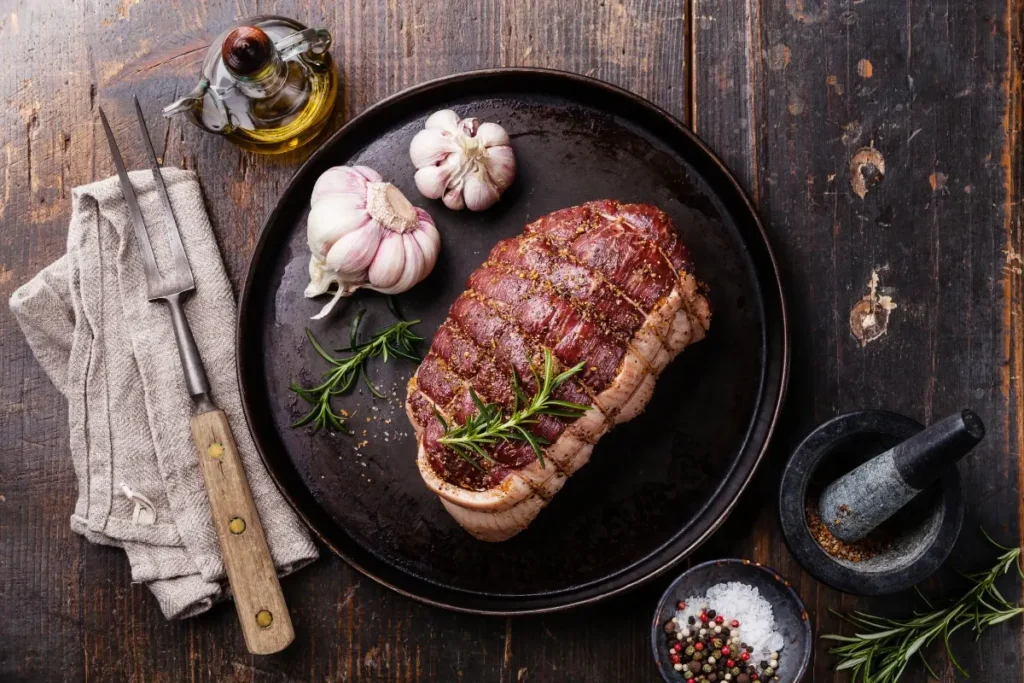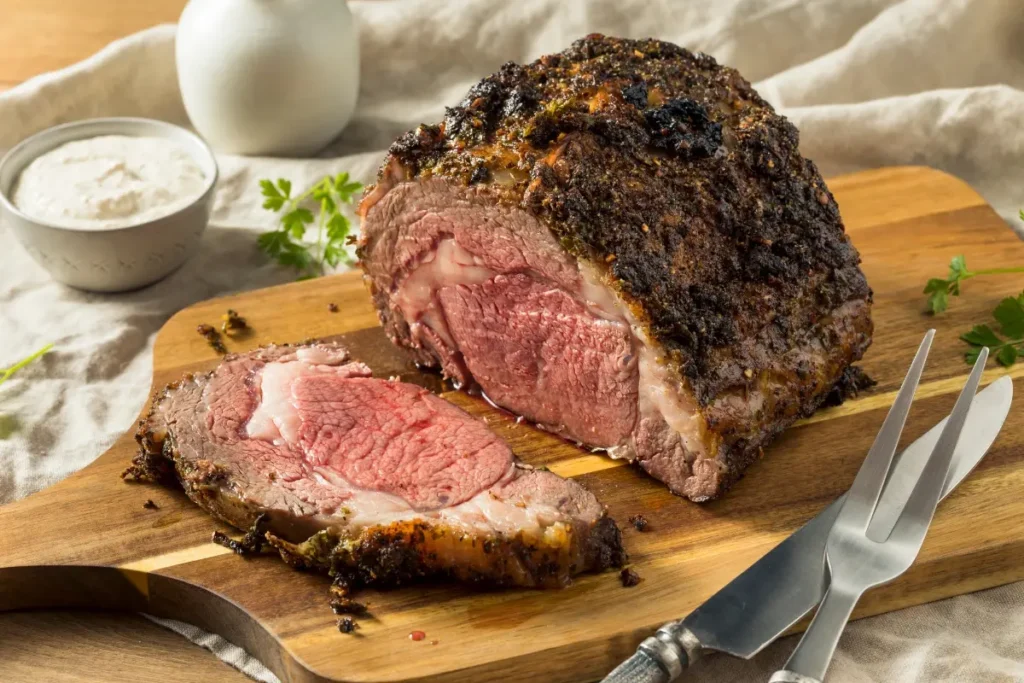Have you ever dreamed of making a restaurant-quality ribeye roast at home? The kind that’s perfectly seared on the outside, meltingly tender on the inside, and bursting with rich, beefy flavor? Well, you’re in the right place!
I grew up watching my mother work wonders in the kitchen, and one thing she always taught me was that good food brings people together. Over the years, I’ve tested numerous methods for achieving the perfect ribeye roast, and today, I’m sharing the ultimate recipe with you.
In this guide, you’ll learn:
The best ingredients
A foolproof step-by-step cooking method
Expert chef tips for the juiciest meat possible
Answers to the most common questions about ribeye roast
Let’s dive in and create a meal your family and friends will never forget.

Ingredients
To cook the perfect ribeye roast, you’ll need a few key ingredients. Here’s what you’ll need:
- 1 Ribeye roast (about 4-6 pounds)
- 2 tablespoons olive oil
- 4 garlic cloves, minced
- 1 tablespoon fresh rosemary, chopped
- 1 tablespoon fresh thyme, chopped
- Salt (preferably kosher salt)
- Freshly ground black pepper
- Optional: 1 cup of beef broth or wine for basting
These ingredients will help bring out the natural flavors of the ribeye roast and create a beautifully seasoned, golden crust. Feel free to adjust the herbs and seasoning to your taste!
Step-by-Step Cooking Instructions
Now, let’s get into the fun part: cooking your ribeye roast. It’s easier than you think, and I’ll guide you through every step. With a little patience, you’ll have a perfectly cooked, flavorful roast.
Start by removing the ribeye roast from the fridge at least an hour before cooking. Letting the meat come to room temperature ensures even cooking. Meanwhile, preheat your oven to 450°F (232°C) to create a beautifully seared crust.
Pat the roast dry with paper towels—this helps the seasoning stick and enhances browning. Coat the meat evenly with olive oil, then generously season with kosher salt, black pepper, minced garlic, onion powder, smoked paprika, and fresh herbs like rosemary and thyme.
Place the roast in the oven and cook at 450°F for 15-20 minutes to develop a golden-brown crust. Then, reduce the temperature to 325°F (163°C) and continue roasting until the desired doneness is reached. Use a meat thermometer for accuracy:
- Rare: 125°F (52°C)
- Medium-Rare (Recommended): 135°F (57°C)
- Medium: 145°F (63°C)
Once done, remove the roast from the oven and let it rest for 20-30 minutes, tented with foil. This allows the juices to redistribute, ensuring tenderness.
Finally, slice against the grain for maximum tenderness. Serve with your favorite sides—mashed potatoes, roasted vegetables, or a crisp salad—and enjoy!
Best Chef Tips for a Juicy Ribeye Roast
Now that you’ve learned the basic steps, let’s go over a few extra tips to make your ribeye roast even better. Trust me, these simple tricks can take your roast to the next level.
1. Use the Reverse Sear Method
If you want to ensure that your ribeye roast is evenly cooked and juicy, try the reverse sear method. Instead of searing the roast at the beginning, roast it at a low temperature (225°F / 107°C) until the internal temperature is about 10°F lower than your target. Then, increase the oven temperature to 500°F (260°C) for the last 10-15 minutes to create a deep, flavorful crust. This method helps keep the meat moist while giving you that perfect crispy exterior.
2. Don’t Skip the Resting Period
Resting the roast is absolutely essential. You might be tempted to cut into it right away, but doing so will cause all the juices to escape, resulting in a dry roast. Let it rest for 20-30 minutes, and your patience will be rewarded with tender, juicy slices.
3. Carve with the Right Knife
The sharpness of your knife matters! A dull knife will crush the meat, making it look like a messy, dry slice. Use a sharp carving knife to get clean, smooth cuts that showcase the beautiful texture of the roast.
4. Pair with the Right Wine
A bold red wine like Cabernet Sauvignon or Malbec complements the rich, beefy flavors of ribeye roast perfectly. The acidity of the wine helps cut through the richness of the meat, creating a balanced and enjoyable meal.
5. Experiment with Flavors
Feel free to experiment with different herbs and spices. Fresh thyme, rosemary, and even a little lemon zest can transform the flavor profile of your roast. Don’t be afraid to make it your own!

Ultimately
Cooking a ribeye roast at home may seem like a challenge, but it’s actually quite simple once you know the right steps. Whether you’re cooking for a special occasion or just a Sunday family dinner, this recipe guarantees that your roast will be tender, juicy, and full of flavor. With the expert tips provided, you’ll be able to create a masterpiece every time. Trust me, your family and friends will be begging for more!
If you’re looking for more inspiration, check out this Herb-Crusted Prime Rib Recipe for a delicious twist on the classic ribeye roast.
Are you ready to try your hand at making the ultimate ribeye roast? I’d love to hear how it turns out, so be sure to drop a comment below and share your results.
FAQs: Your Ribeye Roast Questions Answered
1. Should I cook a ribeye roast covered or uncovered?
It’s best to cook the ribeye roast uncovered to allow the outer layer to develop a beautiful, crispy crust. Covering the roast can trap moisture and prevent the crust from forming.
2. How do I store and reheat leftover ribeye roast?
To store leftovers, place the roast in an airtight container and refrigerate for up to 4 days. To reheat, gently warm the roast in the oven at 275°F (135°C) for 10-15 minutes to preserve its juiciness.
3. Can I cook a ribeye roast in a slow cooker?
Yes, but sear it first for a better crust. Cook on low for 6-8 hours for a tender result, though the texture will differ from oven roasting.
4. What’s the difference between ribeye roast and prime rib?
Both cuts come from the same part of the cow, but prime rib is typically cooked bone-in and may have more fat marbling. Ribeye roast, on the other hand, can be either bone-in or boneless and tends to be a bit leaner, but just as flavorful.
5. Can I use a different cut of beef for this recipe?
While ribeye is the star here, you can use other cuts like sirloin roast or chuck roast. However, the cooking time may vary, and you may not get the same level of tenderness or flavor as you would with ribeye.
6. How can I tell when my ribeye roast is done?
Use a meat thermometer for accuracy. For medium-rare, aim for 135°F (57°C). Remove the roast a few degrees early, as it continues cooking while resting.
Final Thoughts
This ribeye roast recipe is the perfect way to enjoy a high-quality, home-cooked beef roast with minimal effort. By following these step-by-step instructions and pro tips, you’ll master the art of cooking a flawless ribeye roast every time!
Ready to try it? Let us know your results in the comments.

